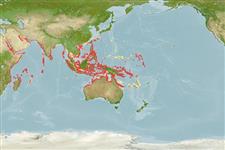Environment: milieu / climate zone / depth range / distribution range
Ecologie
marien rifbewoner; diepte 3 - 30 m (Ref. 90102), usually 5 - 20 m (Ref. 27115). Tropical; 22°C - 30°C (Ref. 27115); 30°N - 22°S, 32°E - 175°E
Indo-West Pacific: from Seychelles to Fiji; north to Japan, south to New Caledonia.
Grootte / Gewicht / Leeftijd
Maturity: Lm ? range ? - ? cm
Max length : 8.5 cm SL mannelijk / geslacht onbekend; (Ref. 48637)
Dorsale stekels (totaal): 7; Dorsale zachte stralen (totaal): 15-17; Anale stekels 1; Anale zachte stralen: 15 - 16. This species is distinguished by the following characters: D VI + I,15-17; A I,15-16; pectoral-fin rays 16-17; scales in longitudinal series 49-54, in transverse series 17-18; interorbital wide, 67-90 % of eye diameter; rear margin of upper jaw ending posteriorly slightly behind or at vertical through anterior margin of eye; first two dorsal-fin spines filiform, elongate, remaining progressively shorter, the sixth dorsal-fin spine almost reaches the origin of the second dorsal; small ctenoid scales on body, cycloid at axil of pectoral fin, nape and entire belly, and in the area between first dorsal fin and pectoral fin; predorsal scales 16-22, scales not reaching to the vertical through the posterior edge of eye, ending at the level of pore G or H'; cheek and opercle naked; scales cover the basal 1/3-1/4 of caudal fin, becoming rapidly smaller and cycloid; prepectoral area with about 4-9 vertical series of fine cycloid scales covering the entire base of the pectoral fin; prepelvic area with cycloid scales, 9-14 in the midventral row; width at anal-fin origin 9.9-10.7% of SL; caudal peduncle depth 75.4-88.9% of its length; head depth 47.3-54.4% of HL; length of 11th second dorsal-fin ray 11.8-14.2% of SL; length of 8th anal-fin ray 13.7-14.9% of SL (Ref. 119548).
Inhabits sheltered bays and inner reefs on fine rubble shaded by large living corals (Ref. 48637). Occurs solitarily, hovering a short distance above sandy bottoms of reef bases. Stomach contents of one specimen comprise of filamentous algae, harpacticoid copepods, ostracods, amphipods, and nematodes (Ref. 9360).
Levenscyclus en paargedrag
Maturiteit | Voortplanting | Paaien | Eieren | Fecunditeit | Larven
Kovačić, M., S.V. Bogorodsky, A.O. Mal and T.J. Alpermann, 2018. Redescription of the genus Koumansetta (Teleostei: Gobiidae), with description of a new species from the Red Sea. Zootaxa 4459(3):453-481. (Ref. 119548)
Status op de Rode Lijst van het IUCN (Ref. 130435)
Gevaar voor de mens
Harmless
Gebruik door de mens
Aquarium: Commercieel
Meer informatie
Lokale namenSynoniemenMetabolismePredatorenEcotoxicologieVoortplantingMaturiteitPaaienPaaiaggregatiesFecunditeitEierenOntwikkeling van de eieren
ReferentiesAquacultuurAquacultuurprofielKweeklijnenGeneticaElectrophoresesErfelijkheidZiektesVerwerkingNutrientsMassaconversie
Tools
Speciale rapporten
Download XML
Internetbronnen
Estimates based on models
Preferred temperature (Ref.
123201): 24.7 - 29.2, mean 28.4 °C (based on 320 cells).
Fylogenetische diversiteitsindex (Ref.
82804): PD
50 = 0.6250 [Uniqueness, from 0.5 = low to 2.0 = high].
Bayesian length-weight: a=0.00708 (0.00333 - 0.01504), b=3.09 (2.92 - 3.26), in cm total length, based on LWR estimates for this (Sub)family-body shape (Ref.
93245).
Trofisch niveau (Ref.
69278): 2.1 ±0.1 se; based on diet studies.
Weerstandsvermogen (Ref.
120179): Hoog, minimale populatieverdubbelingstijd minder dan 15 maanden (Preliminary K or Fecundity.).
Fishing Vulnerability (Ref.
59153): Low vulnerability (10 of 100).
Nutrients (Ref.
124155): Calcium = 162 [70, 326] mg/100g; Iron = 0.867 [0.407, 1.738] mg/100g; Protein = 17.4 [15.4, 19.2] %; Omega3 = 0.0835 [, ] g/100g; Selenium = 26 [12, 64] μg/100g; VitaminA = 114 [24, 529] μg/100g; Zinc = 2.67 [1.65, 4.09] mg/100g (wet weight);
